#1926 the september issue
Explore tagged Tumblr posts
Photo


1926 Georges Lepape, The September issue—always in style. Vogue, September 15, 1926.
#1926#illustration#cover#vogue cover#1926 vogue#1926 vogue cover#the september issue#1926 the september issue#in style#always in style#lepape#vogue
11 notes
·
View notes
Text

A beautiful dancer posing in front of a mirror for the September 1926 issue of UHU Magazine. Image courtesy of Fotografisches Atelier Ullstein.
31 notes
·
View notes
Text


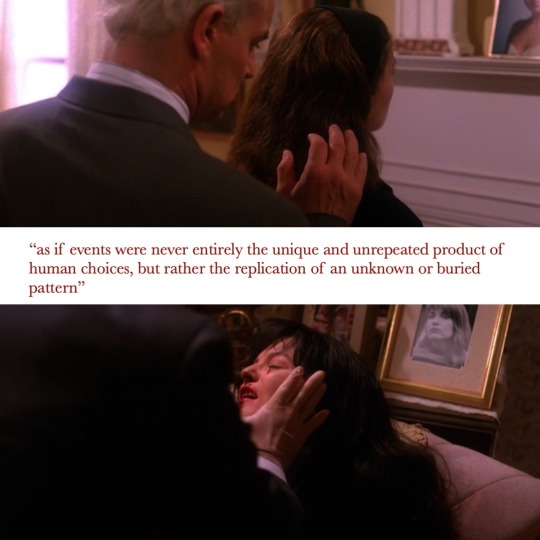






Donna / Maddy / Laura
David B. Morris, Hellebore #1, The Sacrifice Issue ; Simone de Beauvoir, Diary of a Philosophy Student: Volume 1, 1926-1927; September 14th, 1926
#twin peaks#donna hayward#maddy ferguson#laura palmer#leland palmer#web weaving#repetition#faceless#mask#mine#fwwm#fire walk with me
475 notes
·
View notes
Text



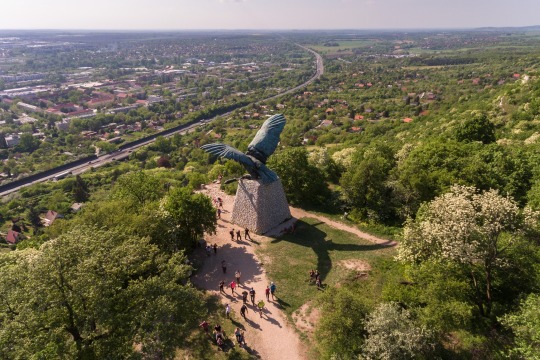

The Turul of Tatabanya by Gyula Donáth 1907
"There were 3 large Turul statues, each with a wingspan of 15 metres, in Kingdom of Hungary (before the country had its borders reconfigured by the Treaty of Trianon). The last of the three stands on a mountain near Tatabánya, Hungary, but the other two were destroyed. It is [one of] the largest bird statue in Europe, and the largest bronze statue in Central Europe. There remain at least 195 Turul statues in Hungary, as well as 48 in Romania (32 in Transylvania and 16 in Partium), 8 in Slovakia, 7 in Serbia, 5 in Ukraine, 1 in Austria and 1 in Croatia. One of the most recently erected, as of 29 September 2012, is in Hungary's Ópusztaszer National Heritage Park.
...
As part of celebrations in 1896 to commemorate the Millenium of the Hungarian conquest, sculpturer Gyula Donáth was assigned to make the Turul Statue. However, due to financial issues, it was finished much later, in 1907. Interestingly, that year was (believed to be) the millennial anniversary of the battle near Tatabánya where Magyar troops defeated Moravians in 907 (exact date uncertain). A similar statue but of smaller size (6 metres) was also made by Donáth, which was placed in the Castle of Buda, at the upper station of the funicular.
The career of the statue has not been free of complications, actually, it is a miracle that it still exists. First it was damaged by the communists in 1919 but it was restored in 1926 by sculpturer Hugó Keviczky upon the government’s direct order. Next it was the Rákosi regime that planned to remove the statue, however, it did not happen finally. As a result of neglect for decades, the statue needed to be extensively restored in 1992. At the same time, it has become the central element in the coat of arms of Tatabánya."
-taken from Wikipedia & OutdoorActive
#hungarian art#hungarian history#magyar#finno ugric#european art#history#europe#sculpture#statue#bird art#animal art#art#hungary
16 notes
·
View notes
Text
Greta Garbo - The Face of the Century

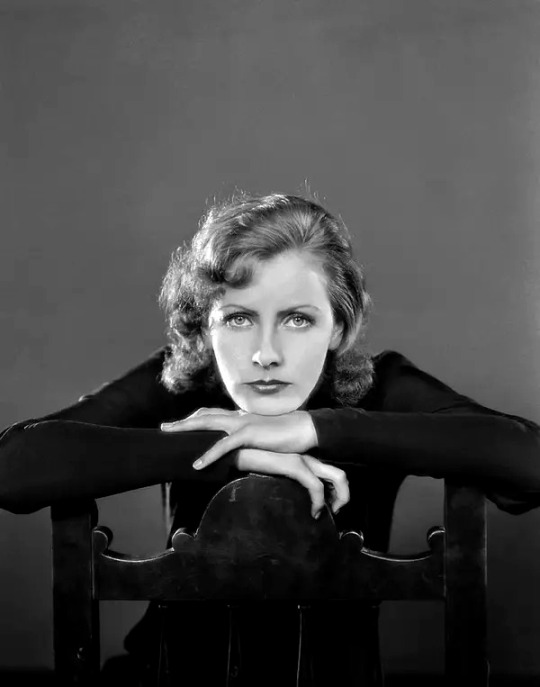


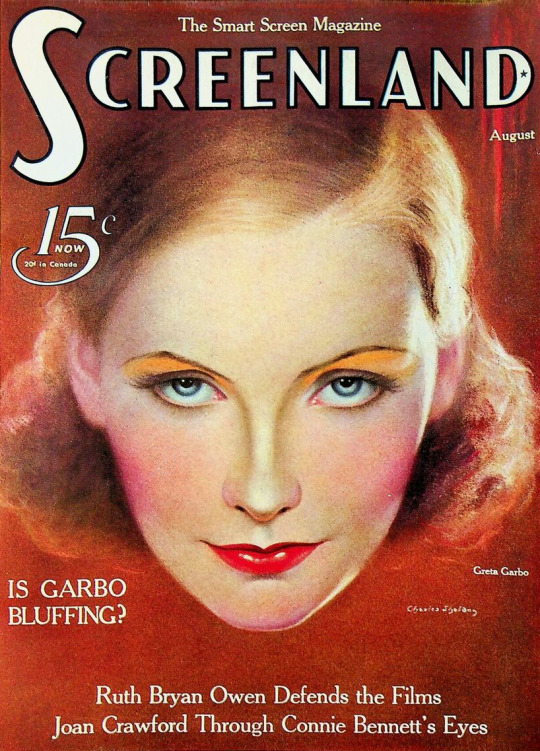


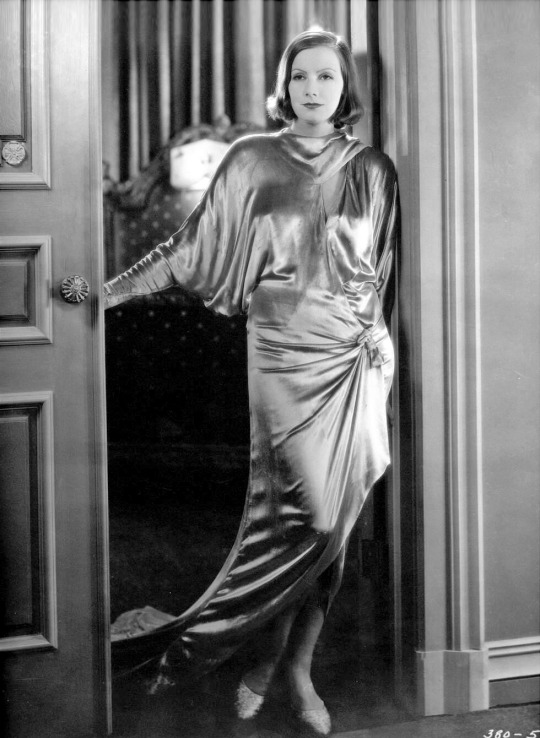

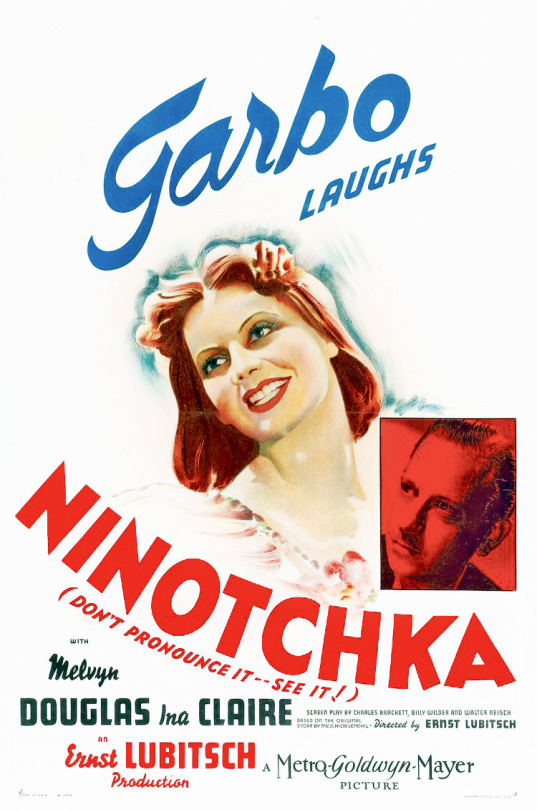


Greta Garbo (born Greta Lovisa Gustafsson in Stockholm, Sweden on 18 September 1905) was a Swedish-born actress who built her global appeal on a carefully maintained mystique during her short career. Called "The Face of the Century," she is regarded as one of the Hollywood's greatest beauties.
Garbo was born into a poor family and dropped out of school at 13 to take care of her father. His death deeply affected her and promised to make a life for herself that was void of financial hardship.
Following her father's death, Garbo worked as a salesperson at PUB department store. After modeling for the store's catalogues, she earned a more lucrative job as a fashion model, which led to a role in her first film in 1922.
She then earned a scholarship at the Royal Dramatic Training Academy, where she met Finnish director Mauritz Stiller, who became her mentor. Louis B. Mayer of Metro-Goldwyn-Mayer wanted Stiller in Hollywood. The director agreed to a contract with one condition: Garbo. Reluctantly, Mayer inked her a deal, too.
She made her first MGM film in 1926, and by 1928, had become MGM's highest box-office star with A Woman of Affairs. She followed it up with several more hits, including Camille (1936). Her career slowed down in the 1940s and retired at 35.
After retiring, Garbo declined all opportunities to appear onscreen, shunned publicity, and led a private life. She died, aged 84, in a New York, as a result of pneumonia and renal failure.
Legacy:
Nominated three times for the Academy Award for Best Actress for her performances in Romance (1930), Camille (1936), and Two-Faced Woman (1941)
Presented an Academy Honorary Award in 1955
Received the New York Film Critics Circle Award for Best Actress twice: Anna Karenina (1935) and Camille (1936)
Won the National Board of Review Best Acting Award three times: Camille (1936), Ninotchka (1939), and Two-Faced Woman (1941)
Was the highest-paid star at MGM for most of her career
Won the Photoplay Awards - Best Performances of the Month for a record eight times: May and December 1926, February and November 1927, March and September 1928, and January and March 1929
Won Best Actress for Anna Christie (1930) and Queen Christina (1933) from Picturegoer Awards
Listed by the Motion Picture Herald as one of America’s top-10 box office draws from 1930 to 1932
Was one of the subjects of French composer Charles Koechlin's "Seven Stars Symphony" (1933)
Granted the Swedish royal medal Litteris et Artibus in 1937
Is one of the celebrities whose picture Anne Frank placed on the wall of her bedroom in the “Secret Annex” in 1942
Voted "Best Actress of the Half Century" in a 1950 Daily Variety opinion poll
Named “the most beautiful woman that ever lived” in 1954 by Guinness World Records
Given the George Eastman Award by George Eastman House in 1957
Has appeared on many postage stamps from, among others, Swedish Posten in 1980 and 2005, Correos de Cuba in 1995, Deutsche Post in 2001, US Postal Service in 2005, Poșta Română issue in 2005, and Australia Post in 2008,
Made a Commander of the Swedish Order of the Polar Star by order of King Carl XVI Gustaf in 1983
Depicted in the film Garbo Talks (1984)
Awarded the Illis Quorum by the government of Sweden in 1985
Had a star was named after her in 1985
Has appeared on commemorative coins from Germany in 1994, France in 1995, and Sweden in 2005
Ranked #38 in Empire's Top 100 Movie Stars in 1997; #25 in Entertainment Weekly’s 100 Greatest Movie Stars of All Time in 1998; #8 in Premiere's 50 Greatest Movie Stars of All Time in 2005 and #25 in 100 Greatest Performances of All Time in 2006 for Ninotchka (1939)
Has had a museum, the Garbosällskapet, dedicated to her in Högsby since 1998
Named the 5th-greatest female star of classic Hollywood cinema in 1999 by the American Film Institute
Inducted in the Online Film and Television Association Hall of Fame in 2002
Chosen in Variety magazine's "100 Icons of the Century" in 2005
Honored by Stockholm City Council in 1992 with a square, Greta Garbos Torg, and a bust of her likeness in 2009
Honored by Norwegian Air Shuttle as its "Tail-fin Hero" on its Boeing 787 Dreamliner in 2016
Featured on 100-krona banknote by Sveriges Riksbank since 2018
Featured in an exhibit at the Postmuseum in 2005, the Belmacz in 2013, the Fotografiska in 2016, the Staley-Wise Gallery in 2016, and Galerie56 in 2023
Honored as Turner Classic Movies Star of the Month for April 2019
Honored with a statue of her, "Statue of Integrity," in 2016, located in the forest in Härjedalen
Has a star on the Hollywood Walk of Fame at 7021 Hollywood Blvd for motion picture

#Greta Garbo#Garbo#The Face of the Century#La Divina#The Swedish Sphinx#Silent Films#Silent Era#Silent Film Stars#Golden Age of Hollywood#Film Classics#Old Hollywood#Vintage Hollywood#Hollywood#Movie Star#Hollywood Walk of Fame#Walk of Fame#Movie Legends#movie stars#1900s#25 Hollywood Legends Born in the 1900s
5 notes
·
View notes
Text
The Life and Times of Queen Elizabeth II: An Era of Transition and the Future of the British Monarchy

Queen Elizabeth II, the longest-reigning British monarch in history, ascended to the throne on February 6, 1952, and her reign lasted until her death on September 8, 2022. Born Elizabeth Alexandra Mary Windsor on April 21, 1926, her life and reign encapsulated a period of extraordinary change both within the United Kingdom and across the globe. Her tenure saw the transformation of the British Empire into the Commonwealth, the end of the Cold War, the dawn of the digital age, and significant shifts in social norms and values. As the figurehead of the UK and 15 other Commonwealth realms, her consistent presence provided a sense of continuity amidst these vast changes. Early Life and Ascension Elizabeth was not born as the direct heir apparent to the throne; her destiny changed with the abdication of her uncle, King Edward VIII, in 1936, which made her father the king and her the next in line. Educated privately at home and serving in the Auxiliary Territorial Service during World War II, Elizabeth's early life was a blend of royal duty and service to her country. Her marriage to Philip Mountbatten in 1947 was a union that lasted 73 years, until his death in 2021, and played a central role in her life and reign. Together, they had four children: Charles, Anne, Andrew, and Edward, whose lives and activities have also been closely followed by the public. Reign and Legacy Throughout her reign, Queen Elizabeth II navigated the monarchy through times of both turbulence and triumph. She worked with 15 UK Prime Ministers, from Winston Churchill to Liz Truss, and met with numerous world leaders, influencing diplomatic relations through her engagements. Her reign was marked by a dedication to public service, with countless engagements, state visits, and ceremonial duties performed with unwavering commitment. Elizabeth's ability to adapt the monarchy to the times without sacrificing its traditions was among her most notable achievements. She embraced television and the internet to connect with the public, including the annual Christmas broadcast, which became a significant aspect of her communication with the Commonwealth and the world. Death and Transition The death of Queen Elizabeth II marked the end of an era and the beginning of a new chapter for the British monarchy. Her son, Charles, succeeded her as King Charles III, bringing to the throne a different perspective shaped by years of advocacy on environmental, social, and architectural issues. The Future Monarchy King Charles III faces the challenge of leading a monarchy in a modern, more questioning world. With debates surrounding the monarchy's funding, its role in society, and the relevance of the Commonwealth in the 21st century, his reign is poised to be one of adaptation and potential transformation. Charles has indicated a desire to streamline the monarchy and focus on sustainability and social issues, which could redefine the royal family's role in British society and beyond. The transition also raises questions about the monarchy's place in the UK and its relevance to younger generations. While the monarchy has historically enjoyed strong support, changing demographics and societal values suggest that its future role may need to evolve. The life and times of Queen Elizabeth II represented a bridge between centuries, embodying tradition while facing forward. As the British monarchy enters a new era under King Charles III, it stands at a crossroads between its historical legacy and the demands of a changing world. How this institution adapts will likely define its relevance and survival in the years to come, continuing a story that has fascinated and engaged people around the globe for more than a millennium. Read the full article
3 notes
·
View notes
Photo
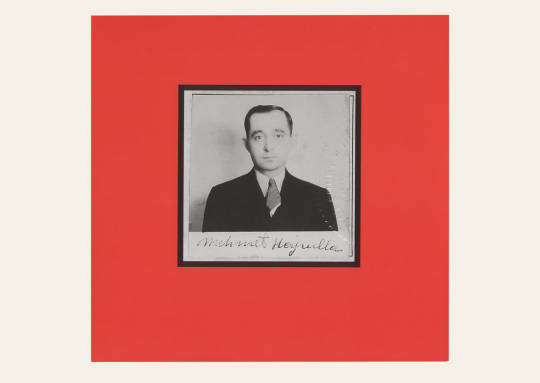
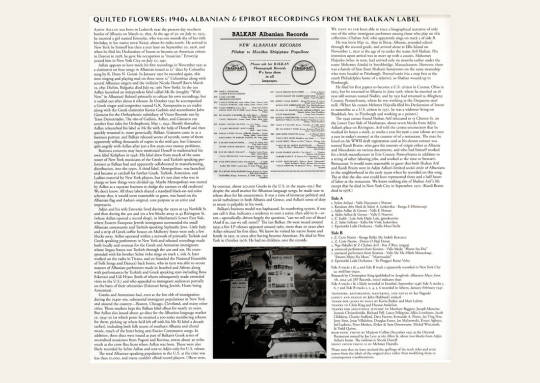
Quilted Flowers: 1940s Albanian & Epirot Recordings from the Balkan Label LP Limited Edition
Ajdin Asllan was born in Leskovik near the present-day southern border of Albania on March 12, 1895. At the age of 30, on July 12, 1925, he married a girl named Emverije, who was one month shy of her 16th birthday, in her native town Korçë, about 80 miles north. He arrived in New York by himself less than a year later on September 20, 1926, and when he filed his Declaration of Intent to become an American citizen in 1928 as a resident of Detroit, he gave his occupation as "musician." Emverije joined him in New York City on July 27, 1931. Asllan appears to have made his first recordings in November 1931 as a clarinetist on four songs issued as 12” discs by Columbia sung in Albanian by K. Duro N. Gerati. In January 1932 he recorded again, this time singing and playing oud on three Columbia 12”s along with several Albanian singers and the violinist Nicola Doneff (born March 21, 1891 Dichin, Bulgaria; died July 19, 1961 New York). In 30s Asllan launched an independent label called Mi-Re (roughly “With New” in Albanian) Rekord primarily to release his own recordings, but it stalled out after about 6 releases. In October 1941 he accompanied a Greek singer and songwriter named G.K. Xenopoulos as an oudist along with the beloved Greek clarinetist Kostas Gadinis and accordionist John Gianaros for the Orthophonic subsidiary of Victor Records run by Tetos Demetriades. The trio of Gadinis, Asllan, and Gianaros cut another four sides for Orthophonic May 1, 1942. Shortly thereafter, Asllan relaunched his label as Me Re with the help of Doneff and then quickly renamed it, more generically, Balkan. Gianaros came in as a business partner, and Balkan released scores of records, some of them seemingly selling thousands of copies in the mid-40s, but Gianaros split angrily with Asllan after just a few years over money problems. By 1947, Doneff had trademarked the Kaliphon label, which drew from much of the same roster of New York musicians of the Greek- and Turkish-speaking performers as Balkan and apparently collaborated in distribution, marketing, and manufacturing into the 1950s, but some business distinction had been drawn. A third label, Metropolitan, was launched and became at catchall for further Greek, Turkish, Armenian, and Ladino material by New York players, but it's not clear who was in charge or how things were divided up. Maybe Metropolitan was started by Asllan as a separate business to dodge the taxman or old creditors? We don’t know. All three labels shared a standard black-on-red color scheme that, it would seem reasonable to guess, was based on the Albanian flag and Asslan’s original, core purpose as an artist and impresario. Adjin and Emverije lived during the 1930s into the 50s first at 143 Norfolk St. and then at 42 Rivington St. (where Asllan opened a record shop), in Manhattan's Lower East Side, where Eastern European Jewish immigrants surrounded the small Albanian community and Turkish-speaking Sephardic Jews, and abutting Little Italy and a strip of Greek coffee houses on Mulberry Street. He worked within a network of primarily Turkish- and Greek-speaking performers in New York and released recordings prolifically made both locally and overseas through the 40s and 50s. He corresponded with his brother Selim (who sings on track 1, side A, later worked on the radio in Tirana and co-founded the National Ensemble of Folk Songs and Dances) back home, who was able to secure masters of Albanian performers recorded in Istanbul and Athens along with performances by Turkish- and Greek-speaking stars including Rosa Eskenazi and Udi Hrant (both of whom subsequently made extended visits to the U.S.) Greeks and Armenians had, even at the low ebb of immigration during the 1940s-50s, substantial immigrant populations in New York and around the country - Boston, Chicago, Cleveland, and many other cities. Those markets kept the Balkan label afloat for nearly 20 years. But Asllan also issued about 40 discs for the Albanian-language market ca. 1945-50 (at which point he retained a 500-series numbering scheme for them, picking up where he’d left off with his Me Ri label a decade earlier), including both folk music of southern Albania and choral music, much of the latter anti-Fascist Communist songs. In addition, three discs were issued as part of Balkan’s Greek series of uncredited musicians from Pogoni and Konitsa, towns about 30 miles south as the crow flies from where Asllan was born. The total Albanian-speaking population in the U.S. at the time was less than 10,000, and many couldn’t afford record players. But despite the small market for Albanian-language songs, he made sure to release discs for his countrymen. It was a time of immense political and social turbulence in both Albania and Greece, and the sense of duty to music is palpable in his work. Balkan’s business model was haphazard. Its numbering system, if one can call it that, indicates a tendency to start a series, then add to it - or not - sporadically, driven largely the question, “can we sell 500 of these? (And if so, can we sell 1000?)” The last Balkan 78s were issued around 1959; a few LP releases appeared around 1960, more than 20 years after Asllan released his first discs. We know he visited his native home and family in 1951, 25 years after having become American. He died in New York in October 1976. He had no children, save the records. ========= We have so far been able to trace a biographical narrative of only one of the other immigrant performer among those who play on this collection, Chaban Arif, who apparently sings on track 9. He was born May 22, 1899 in Berat, Albania, attended school through the second grade, and arrived alone at Ellis Island on November 2, 1920 at the age of 19 under the name Aril Shaban. His intention upon arrival was to meet up with a cousin, Mahomet Hajrules (who, in turn, had arrived only six months earlier under the name Mehemet Airula) in Southbridge, Massachusetts. However, there was a family of four from Shaban’s hometown on the same steamship who were headed to Pittsburgh, Pennsylvania (via a stop first at the south Philadelphia home of a relative), so Shaban wound up in Pittsburgh. He filed his first papers to become a U.S. citizen in Canton, Ohio in 1925, but he had returned to Albania in June of 1928, where he married an 18 year old woman named Nadire, and by 1931 had returned to Allegheny County, Pennsylvania, where he was working at the Duquesne, Pennsylvania Carnegie steel mill. (When his cousin Mehmet Hajrulla filed his Declaration of Intent to naturalize as a U.S. citizen in 1937, he was a widower living on Braddock Ave. in Pittsburgh and working as a painter.) The 1940 census found Shaban Arif relocated to 55 Clinton St. on the Lower East Side of Manhattan, about seven blocks from Adjin Asllan’s place on Rivington. Arif told the census enumerator that he worked 60 hours a week, 52 weeks a year for $916 a year (about $17,000 a year in today’s money) at the counter of of a restaurant. The man he listed on his WWII draft registration card as his closest contact was named Kardi Braim, who gave his country of origin either as Albania and Macedonia on different documents, had himself worked for a brick manufacturer in Erie County, Pennsylvania in addition to a string of other laboring jobs and worked at the time at Stewart’s Restaurant. It would seem reasonable to guess that both Shaban Arif and Kardi Braim were in Adjin Asllan’s limited social circle of Albanians in the neighborhood in the early 1940s when he recorded on this song. The $1 that the disc cost could have represented three and a half hours of labor at the restaurant. We know nothing else of Shaban Arif’s life except that he died in New York City in September, 1971. (Kardi Braim died in 1978.)
6 notes
·
View notes
Text
Black History Month is an annual celebration of achievements by African Americans and a time for recognizing their central role in U.S. history. Also known as African American History Month, the event grew out of “Negro History Week,” the brainchild of noted historian Carter G. Woodson and other prominent African Americans. Since 1976, every U.S. president has officially designated the month of February as Black History Month. Other countries around the world, including Canada and the United Kingdom, also devote a month to celebrating Black history.

Origins of Black History Month
The story of Black History Month begins in 1915, half a century after the Thirteenth Amendment abolished slavery in the United States.
That September, the Harvard-trained historian Carter G. Woodson and the prominent minister Jesse E. Moorland founded the Association for the Study of Negro Life and History (ASNLH), an organization dedicated to researching and promoting achievements by Black Americans and other peoples of African descent.
READ MORE: The Man Behind Black History Month
Scroll to Continue
Known today as the Association for the Study of African American Life and History (ASALH), the group sponsored a national Negro History week in 1926, choosing the second week of February to coincide with the birthdays of Abraham Lincoln and Frederick Douglass. The event inspired schools and communities nationwide to organize local celebrations, establish history clubs and host performances and lectures.
In the decades that followed, mayors of cities across the country began issuing yearly proclamations recognizing "Negro History Week." By the late 1960s, thanks in part to the civil rights movement and a growing awareness of Black identity, "Negro History Week" had evolved into Black History Month on many college campuses.
President Gerald Ford officially recognized Black History Month in 1976, calling upon the public to “seize the opportunity to honor the too-often neglected accomplishments of Black Americans in every area of endeavor throughout our history.” Today, Black History Month is a time to honor the contributions and legacy of African Americans across U.S. history and society—from activists and civil rights pioneers such as Harriet Tubman, Sojourner Truth, Marcus Garvey, Martin Luther King Jr., Malcolm X and Rosa Parks to leaders in industry, politics, science, culture and more.
Black History Month 2023 Theme
Since 1976, every American president has designated February as Black History Month and endorsed a specific theme.
The Black History Month 2023 theme, “Black Resistance,” explores how "African Americans have resisted historic and ongoing oppression, in all forms, especially the racial terrorism of lynching, racial pogroms and police killings," since the nation's earliest days.
READ MORE: Black History Milestones
Photo Galleries
Black Women Leaders
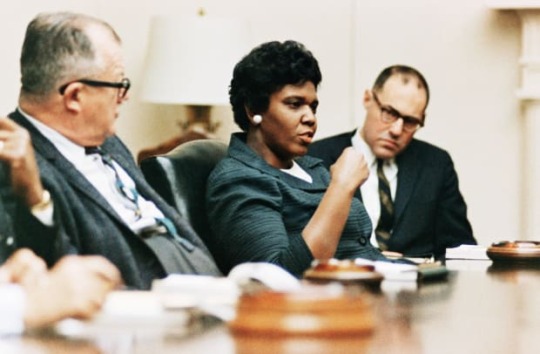
4 notes
·
View notes
Text
SAINTS&READING: THURSDAY, OCTOBER 10, 2024
september 27_october 10
HIEROMARTYR AND METROPOLITAN OF MOSCOW AND KRUTITSY PETER POLYANSKY (1937)

New Hieromartyr Peter, Metropolitan of Krutitsy was glorified by the Russian Orthodox Church at the Synod of Bishops of the Russian Orthodox Church on February 23, 1997.
Saint Peter was born in the Voronezh region, and studied at the Moscow Theological Academy, graduating in 1892, where he then continued as inspector. After a short stay at the seminary of Zhirovits in Belarus as inspector, he was appointed secretary of the Synodal Education Committee becoming de facto inspector of all the theological schools of the Russian Orthodox Church.
Unlike many of his contemporaries who had graduated from a theological academy, Peter Polyansky did not seek ordination, and for a long time remained a layman. As secretary of the Synodal Education Committee he traveled widely, visiting innumerable theological establishments, meeting and knowing many people. Gifted with an outstanding intellect, a firm character and a sociable nature, he was widely known and made many friends. He exercised a beneficial influence on the religious education of future priests.
In 1917-18, Peter Polyansky took part in the work of the local Council of the Russian Orthodox Church, when Saint Tikhon (April 7) was elected Patriarch. The latter made Peter Polyansky one of his closest aides, and persuaded him to become bishop; the Patriarch wished to consolidate the leadership of the Church in what was fast becoming the darkest time for the Church in many centuries. In 1920 Peter Polyansky was made a monk and auxiliary bishop for the diocese of Moscow; in a matter of months he was appointed Metropolitan of Krutitsy, one of the highest ranking bishops of the Russian Orthodox Church.
Patriarch Tikhon died on April 7, 1925, the day of the Annunciation (March 25). Foreseeing increasing troubles and uncertainty for the Church, thinking that the government would not allow a Church council to assemble and elect the next patriarch, Saint Tikhon took an administrative decision aimed at securing a smooth succession when he died. He nominated three bishops in order of priority, as locum tenens; the third was Metropolitan Peter Polyansky. When the first two choices were found to be in prison and thus unable to assume the leadership of the Church, this heavy task befell Metropolitan Peter.
Persecution against the Church was raging, the government gave its support to the splinter group “The Living Church” in an attempt to discredit and destroy the official Orthodox Church. A great number of bishops had been imprisoned or exiled to remote parts of the country, and were unable to have a clear understanding of the prevailing situation. The whole country was in turmoil; the so-called Living Church energetically tried to replace the true Church.
In the absence of a patriarch, people did not know whom to believe and to whom to give their allegiance. Metropolitan Peter then issued an uncompromisingly firm “Letter to the Russian Church” where he described the position of the Church vis a vis the authorities and vis a vis the “Living Church.” He made no compromises with anybody, and stood firm in the truth of Christ. This letter helped the Church to strengthen itself but caused the Metropolitan to be arrested.
The history of the few months in which a campaign was master-minded by the Commissar for religious affairs, Tuchkov, to compromise and weaken Saint Peter, shows how determined the government was to defeat the head of the Church, but this did not break him. On December 10, 1925, Saint Peter was put under house arrest, and two days later sent to the Lubianka prison; in May 1926 he was transferred to the Suzdal fortress, then back to the Lubianka, and finally, in December, he was sent to Siberia, first to Tobolsk, then to the village of Abalak on the banks of the river Irtysh which he reached in 1927. Many of the other bishops had experienced a similar fate, the dioceses remaining without their shepherds.
In August 1927, Metropolitan Peter was taken to another destination beyond the Arctic Circle, a place called Khe on the mouth of the Ob, in the frozen tundra. For a little while he lived there peacefully, recovering from the arduous journey. However, on August 29, the day of the Beheading of the Saint John the Baptist, he suffered his first attack of angina and had to stay in bed. Two paramedics who came from a far distance by river in a boat manned by a native, advised him to be seen by a doctor and be transferred to a hospital. The Metropolitan wrote to the authorities at the GPU, but never got a reply, or money, or provisions, although he knew that several parcels had arrived in Tobolsk addressed to him.
This northern region's damp, cold climate was extremely harmful to him in his condition. Eventually, he was taken back to Tobolsk towards the end of September. Unexpectedly, he had an interview with Tuchkov, who offered him freedom if he surrendered his locum tenens title, but he remained firm and refused to compromise. He was then sent back to Khe for another three years of exile but was never granted his freedom. In Moscow in 1936, ten years after his first imprisonment, believers were waiting for his return, counting on the end of his ten-year term of exile. They never saw him again. He may have been moved for the last time to a monastery nearer central Russia, where he was a little less constrained but with no freedom to write or communicate with the world. He was shot by the decision of the Soviet authorities after years of prison and exile.
MARTYR CALISTRATUS AND HIS 49 COMPANIONS IN CARTHAGE (304)

Saint Callistratus was a native of Carthage. An ancestor of Saint Callistratus, Neochorus, had served under the emperor Tiberius in Palestine, under the command of Pontius Pilate, the procurator of Judea, and was a witness to the suffering on the Cross of our Lord Jesus Christ, His voluntary death and glorious Resurrection.
The saint’s father was a Christian, and he raised his son in faith and piety. Also like his father, Saint Callistratus became a soldier and excelled among his pagan military comrades by his good conduct and gentle disposition.
At night when everyone slept, he usually stayed up at prayer. Once, a soldier sleeping nearby heard Saint Callistratus invoking the Name of the Lord Jesus Christ, and he reported this to the military commander, who in turn summoned Callistratus, interrogated him and wanted to make him offer sacrifice to idols. The saint resolutely refused to do this, so the military commander ordered that the saint be beaten. Then, covered with wounds, the saint was dragged over sharp stones. The beating and the torments did not sway the firm will and brave endurance of the sufferer.
The saint was sewn up in a leather sack and drowned in the sea. By God’s mercy, however, the sack struck a sharp rock and was torn open. Saint Callistratus came to dry land unharmed, carried by dolphins. Viewing such a miracle, forty-nine soldiers came to believe in Christ. Then the military commander threw Saint Callistratus and the believing soldiers into prison. Before this, all of them were subjected to innumerable floggings.
In jail Saint Callistatus continued to preach the Word of God to the soldiers and he bolstered their spirits for martyrdom. Summoned again before the military commander, the sufferers firmly confessed their faith in Christ, after which they were bound hand and foot and thrown into the depths of a great lake behind a dam. But there their bonds broke, and with bright faces the holy martyrs stood in the water, rejoicing in their Baptism, which coincided with the act of martyrdom.
Beautiful bright crowns appeared over their heads, and all heard a voice: “Be brave, Callistratus, with your company, and come rest in the eternal habitations.” At the same time, the earth shuddered and an idol standing nearby fell down and smashed. Seeing this, another 135 soldiers also believed in the Lord Jesus Christ. The military commander, fearing a mutiny in the army, did not put them on trial, but again imprisoned Saint Callistratus with his 49 companions, where they fervently prayed and gave thanks to the Creator for giving them power to endure such sufferings.
At night the martyrs were cut to pieces with swords by order of the military commander. Their holy relics were buried by the 135 soldiers who remained alive. Later, a church was built on the spot of their sufferings, as Saint Callistatus had foretold.
Source: Orthodox Church in America_OCA


Ephesians 1:1-9
1 Paul, an apostle of Jesus Christ by the will of God, To the saints who are in Ephesus, and faithful in Christ Jesus: 2 Grace to you and peace from God our Father and the Lord Jesus Christ. 3 Blessed be the God and Father of our Lord Jesus Christ, who has blessed us with every spiritual blessing in the heavenly places in Christ, 4 just as He chose us in Him before the foundation of the world, that we should be holy and without blame before Him in love, 5 having predestined us to adoption as sons by Jesus Christ to Himself, according to the good pleasure of His will, 6 to the praise of the glory of His grace, by which He made us accepted in the Beloved. 7 In Him we have redemption through His blood, the forgiveness of sins, according to the riches of His grace 8 which He made to abound toward us in all wisdom and prudence, 9 having made known to us the mystery of His will, according to His good pleasure which He purposed in Himself,
Luke 6:12-19
12 Now it came to pass in those days that He went out to the mountain to pray, and continued all night in prayer to God. 13 And when it was day, He called His disciples to Himself; and from them He chose twelve whom He also named apostles: 14 Simon, whom He also named Peter, and Andrew his brother; James and John; Philip and Bartholomew; 15 Matthew and Thomas; James the son of Alphaeus, and Simon called the Zealot; 16 Judas the son of James, and Judas Iscariot who also became a traitor. 17 And He came down with them and stood on a level place with a crowd of His disciples and a great multitude of people from all Judea and Jerusalem, and from the seacoast of Tyre and Sidon, who came to hear Him and be healed of their diseases, 18 as well as those who were tormented with unclean spirits. And they were healed. 19 And the whole multitude sought to touch Him, for power went out from Him and healed them all.
#orthodoxy#orthodoxchristianity#easternorthodoxchurch#originofchristianity#spirituality#holyscriptures#gospel#bible#wisdom#faith#saints#jesus christ
1 note
·
View note
Text
Milwaukee Independent: Reggie Jackson: The little-known history of Black History Month
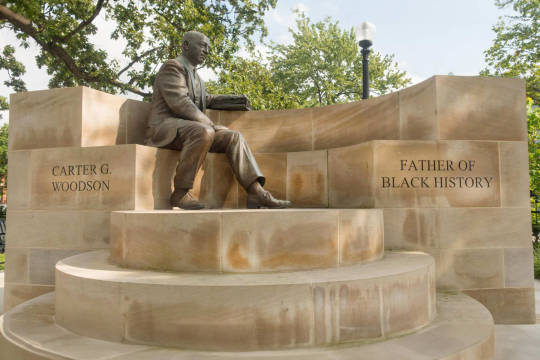
“Those who have no record of what their forebears have accomplished lose the inspiration which comes from the teaching of biography and history.” – Dr. Carter G. Woodson, Founder of Black History Month
“The foremost purpose of Black History Month is to make all Americans aware of this struggle for freedom and equal opportunity. It is also a time to celebrate the many achievements of Blacks in every field, from science and the arts to politics and religion. It not only offers Black Americans an occasion to explore their heritage, but it also offers all Americans an occasion and opportunity to gain a fuller perspective of the contributions of Black Americans to our Nation. The American experience and character can never be fully grasped until the knowledge of Black history assumes its rightful place in our schools and our scholarship.” – President Ronald Reagan, Proclamation 5443, National Black (Afro-American) History Month, 1986
Ever since more than 200,000 Black men joined the Union Army and Navy, helping to turn the tide of the U.S. Civil War in favor of the Union, leading to the end of legal slavery, and freeing the nearly four million enslaved Black people, we have celebrated our journey and our progress as a people.
In 1915, fifty years after emancipation, Dr. Carter G. Woodson, was in Chicago with thousands of other Black people looking at exhibits celebrating Black life. While attending this event he decided on September 9, 1915 – along with several colleagues – to form the Association for the Study of Negro Life and History, now known as the Association for the Study of African American Life and History, as a way to promote the scientific study of Black life and history.
The following year he published the first Journal of Negro History. Woodson wanted to keep up the tradition of celebrating our people, which was done consistently each year after slavery ended. In 1924, Woodson and his fraternity brothers from Omega Psi Phi, created Negro History and Literature Week. They later renamed it Negro Achievement Week.
Two years later Woodson sent out a press release announcing Negro History Week in February 1926. He picked February to take advantage of the celebrations by Blacks around the country for the lives of Frederick Douglas on February 14 and Abraham Lincoln on February 12, during the week of their births. He asked people around the country to: organize their communities for the celebration, appeal to their boards of education to adopt textbooks on Negro History, raise funds to purchase books related to Negro history for local schools and libraries, and gather documents on their family history to share, organize local chapters of the ASNLH.
This celebration was a continuation of efforts to acknowledge the progress we made as a people since gaining freedom from slavery. In 1937 the great educator, Mary McLeod Bethune, suggested that Woodson establish the Negro History Bulletin which would document our history and offer an annual theme for the celebration. As a result of these efforts, teachers demanded materials for their schools, and cities across the country issued proclamations acknowledging Negro History Week.
Schools across the South expanded their efforts to teach Black history. Freedom schools established during the Civil Rights Movement taught specific courses on Black history. As Blacks discarded the use of the term Negro, the celebration was changed to Black History Month. In 1976 Black leaders advocated for extending the celebration for the entire month of February, as was already being done in several cities. For the first time ever, U.S. presidents issued proclamations endorsing Black History Month.
Finally in 1986, a joint effort in both houses of Congress came about to acknowledge the importance of Black History Month. President Reagan issued Proclamation 5443 on February 24, where he spoke about why Black History Month is important to all Americans.
As we approach the 100th anniversary of the first formal Negro History Week celebration, it is important that we acknowledge the work of Dr. Woodson, the second Black person to receive a doctorate degree from Harvard, and keep in mind that Black History is American History.
We live in a time where far too many people are attempting to scare us into eliminating this history being taught in our schools. We cannot stand for such foolishness. We must be ever vigilant to not erode the progress we have made over decades. I celebrate our history 24 hours a day, 365 days each year because I am so proud of the community that I come from.
The trials and tribulations of Black people show our resilience and why we should be celebrated for our contributions to this country. Let us not treat it like Black Trivia Month, as far too many do in my opinion. We have so much to gain from taking pride in the work we have done to move the country toward those original ideals of the Founding Fathers, even if we have been denied membership in that world for far too long.
If President Reagan, a very conservative Republican, very publicly advocated for Black History Month, there is no reason current GOP members cannot have the same reverence for Black history.
“Black history in the United States has been a proving ground for America’s ideals. A great test of these ideals came with the Civil War and the elimination of slavery. Another test came a century later, in the struggle for practical recognition of the rights already won in principle—the abolition of legalized segregation and second-class citizenship.” – President Ronald Reagan, Proclamation 5443, National Black (Afro-American) History Month, 1986
“There is no more powerful force than a people steeped in their history. And there is no higher cause than honoring our struggle and ancestors by remembering.” – Dr. Carter G. Woodson, Founder of Black History Month
0 notes
Text
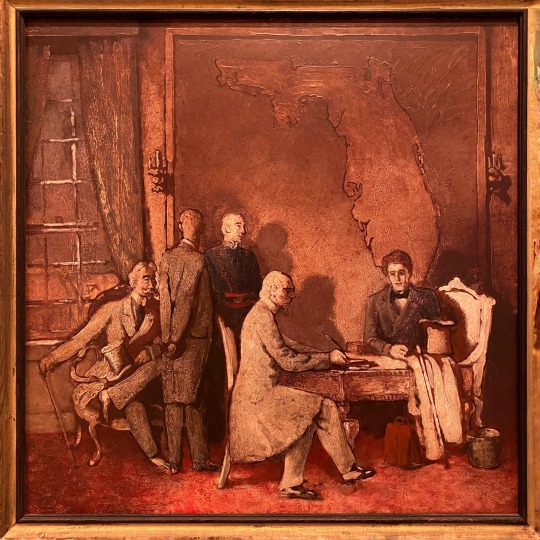

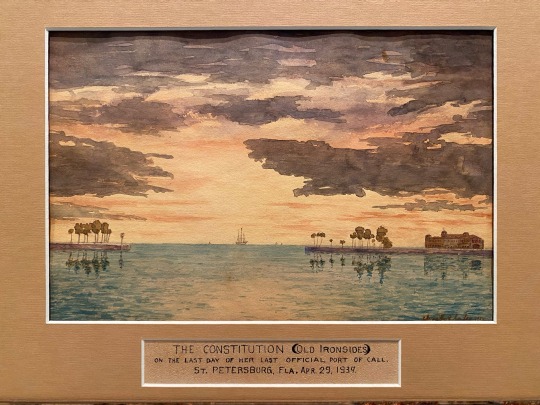
Finding Lost Florida Art at the Chicago Century of Progress, 1933-1934
January 2, 2015 by Fred Frankel
Imagine how you might feel if national icons like John Trumbull’s painting of The Declaration of Independence or Emanuel Leutze’s Washington Crossing the Delaware were lost. On a state level, that’s exactly what happened in Florida. In 1931 the state sponsored an art competition to find six artists to paint large murals depicting important events in the states history for the Florida building at the Chicago Century of Progress. The murals, eventually to be placed in the capitol in Tallahassee,were commissioned, painted, exhibited and then lost. This is the story of those lost paintings and the recent discovery of works submitted for the competition.
It was a difficult time for Floridians: the Florida land boom ended in 1925 when real estate prices crashed; the hurricane of 1926 flattened Miami, and the Depression straight lined tourism.
When the state legislature met in 1931 they wanted to stimulate tourism. They learned that Chicago planned to celebrate the one hundredth anniversary of its incorporation with a World’s Fair: the Chicago Century of Progress. All states were invited. Florida and eleven others, including California and Georgia, decided to participate in a great central quadrangle, the Court of States. Here was a unique chance to tell the country about the Sunshine State.
In 1931 Florida was still a relatively small state with a population of 1.5 million and, with the exception of Osceola and the Seminole Indian Wars, unfamiliar with the national stage. That would change in Chicago. The state would go all out: even minting a small coin that proclaimed: “Florida where summer spends the winter.”
The Florida exhibit included a half acre orange grove, dozens of palm trees, an outdoor garden with wild orchids, a lily pond, and a Seminole village. Inside, the two floored pavilion designed by Phineas Paist, the architect of Coral Gables, featured a Spanish courtyard, its sky crossed by a flight of ibis, dioramas of state industries, the sculpture, Spirit of Florida, by George Ganiere, professor of sculpture at Stetson University, paintings of the sky lines of the larger cities, and six murals, each ten by ten feet, depicting the states’ history.
It all began in September of 1931 when the state legislature authorized a Florida exhibit at the Chicago fair. Governor Doyle Carlton appointed six senators and six representatives to the Florida Century of Progress Commission with Senator W.C. Hodges as chairman,
The commission began a statewide campaign to raise $250,000 for the exhibit and appointed a Florida Century of Progress Jury to find artists of recognized ability to execute paintings of important episodes in Florida’s history. The jury consisted of Mrs. Eve Alsman Fuller, of St. Petersburg, chairman, Mrs. Doyle Carlton, Mrs. Cary Landis, wife of the Attorney General, Senator Hodges, and sculptor C. Adrian Pillars of Jacksonville and Sarasota.
The state of Florida commissioned Pillars for sculptures of Confederate General Kirby Smith and John Gorrie, the inventor of air conditioning, that represent Florida in the United States Capitol Rotunda in Washington, D.C. Pillars’ sculpture, Life, a memorial to Florida’s dead in World War I, stands in Memorial Park in Jacksonville.
Eve Fuller was president of the Florida Federation of Art (FFA) and director of the Florida Art Project (FAP) sponsored by the Federal governments Works Progress Administration (WPA). The FFA, with both amateur and professional artist members, had clubs in almost every major city in the state. During the Depression the FAP put unemployed professional artists back to work.
Mrs. Fuller invited all artists working for the FAP to enter the competition. Members of the FFA were notified and invited to participate. On August 10, 1932 Senator Hodges issued a press release that appeared in newspapers around the state the following day with, “An invitation to all artists who live in Florida or who paint Florida scenes to submit paintings for use in the states exhibit at the World Fair in Chicago next year.”
Paintings were to be submitted in categories: Discovery, Exploration, Christianization, Colonization, Seminole War, and Reconstruction. Artists could enter one painting in each category. The paintings were to be of uniform size, 30 by 30 inches, in simple frames, and signed on the back by the artist.
The jury met at the Ringling Museum of Art in early November 1932. Mrs. Fuller as chairman of the jury expressed pleasure at the interest in the contest by so many of the artists throughout the state and in the character of the work submitted.
Some of the preliminary paintings for the competition have survived and illustrate the mural work done by the winning artists and those awarded honorable mention.
The winning artists were:Addison Burbank for Discovery: Ponce De Leon taking possession of the land for Spain. Burbank was born in California, the son of W. F. Burbank, founder of the Oakland Tribune. In 1926 after art study in Europe he had a solo exhibition of his paintings at the Ferargil Galleries in New York City. Burbank later moved to Miami. The St. Augustine Record, January 13, 1933, quotes Burbank on his visit to St. Augustine, “Through your courtesy Mrs. Burbank and I had the pleasure of visiting the Arts Club (of St. Augustine) Friday evening and viewing the splendid work of yourself and fellow members. We of the Miami Art League envy you your beautiful home and splendid facilities for study and play. St. Augustine is a mine for artists, and we hope the Arts Club will prove the nucleus of a famous art center. Our visit to St. Augustine was in search of material for the mural of Ponce de Leon’s discovery of Florida, for which I received the first award in the state competition held in November. Mrs. Underwood of the Historical Society gave me great help. Mr. Burbank is painting the murals for the Florida exhibits in the Century of Progress Exposition.” Burbank’s mural is lost.
Max Bernd-Cohen for Exploration: DeSoto explores the west coast of Florida. In 1931 Max Bernd-Cohen was one of the first instructors at the Ringling School of Art. Before coming to Sarasota Bernd-Cohen spent two years as a guest lecturer at the Central School of Arts and Crafts in London, England. He taught at the Imperial University, Sapporo, Japan and was chairman of the art department at Florida Southern University in Lakeland. Art lovers from nearby cities attended his popular lectures at the Ringling School, and he was in demand as a speaker throughout the state of Florida. In 1955 he was honored with inclusion, in the Ringling Museum of Art exhibit, Fifty Florida Artists.
Wallace W. Hayn for Christianization: the Spanish building of the first missions in the state. Hayn, like his art, has been lost to history.
Chester J. Tingler for Colonization: Andrew Jackson taking over Florida for the United States. Chester Tingler was an important Miami muralist. Born in Sweden, he grew up in Buffalo, New York where his drawings for the Albright Art Gallery won him a one year art scholarship. After study at the Art Students’ League in New York City, Tingler was employed for some years as scenic and costume designer for Broadway shows produced by Flo Ziegfeld and the Schuberts. In 1917 he received the Gertrude Vanderbilt Whitney award for mural painting. Tingler moved to Miami in 1922 and was later employed by the WPA and the FAP as supervisor of the mural art project for the Miami district. Tingler did murals for the Miami High School library, the Clewiston Airport, Shenandoah Junior High and Ponce de Leon High School. Tingler was named Artist of the Year in 1944-1945 by the Miami Women’s Club and the American Artists Professional League. He was an art instructor with the Terry Art Institute and a regular exhibitor at the Mirell Gallery in Coconut Grove and the Washington Art Galleries of Miami Beach.
Eleanor King was just twenty-three when she painted General Jackson Besieging Media de Luna of San Carlos for the state competition. One of the youngest artists to enter, she did not win, though her painting made the finals, where King lost to Chester Tingler. The Pensacola Journal noted, “Miss King is in receipt of a letter from Mr. Tingler asking her to help him with his painting in the matter of uniforms and accoutrements, both of American and Spanish soldiers. . . . In response . . . the young artist has made it clear that, should she assist in this work, she would expect recognition. She spent many months over her painting, and had the personal assistance of Julian Yonge, authority on Florida history. . . . It was never clear to Pensacola how it could be possible to present Florida historically without giving Pensacola a leading place in portraiture. . . . Is Mr. Tingler to paint a picture of Pensacola’s past? And if he is, will this young artist assist him? Pensacola will learn of this with interest, and every effort should be made to assure that both she and Pensacola are properly recognized in the painting that is to depict the early history of Florida.”
The Pensacola Journal of April 6, 1934, “Eleanor King, young Pensacola artist, is rapidly gaining more than local distinction. This scene was painted in competition for art work to be placed in the Florida exhibit at the Century of Progress Exposition in Chicago and received special mention. Miss King has exhibited in New York at the National Academy, and in Birmingham, Alabama at the annual exhibit of the Southern States Art League, her work attracted much attention….”
Later King married Lawrence Salley and moved to Tallahassee. Mrs. Salley was in New York City in 1939 for the New York World’s Fair. A letter home to her family is quoted in the Pensacola Journal, May 2, 1939, “The Montross Gallery on Fifth Avenue is going to handle my work all the time and plans to open their season in the fall with a one man show of my watercolors, thirty of them.” The Ferrigil Galleries on 57th Street carried her oils, landscapes, and seascapes. King did portraits of many prominent Floridians including historian Caroline Brevard, hung in the school named for her in Tallahassee; a portrait of Chief Justice Fred Davis, hung in the Supreme Court in Tallahassee; and a portrait of William Sheats, who for twenty years, was state superintendent of schools in Florida, hung in the education room of the state capitol.
Mark Dixon Dodd for Seminole War: Osceola driving a knife through the peace treaty at Moultrie Creek. Mark Dodd moved from New York City to St. Petersburg in 1925. He soon became a prominent member of the city’s art community. Dodd opened the Mark Dixon Dodd School of Art on Beach Drive in 1930. In 1936, as his reputation as an artist and teacher grew, Dodd designed and built fifteen homes on Coffee Pot Bayou. In each he placed one of his paintings, usually anchored to the wall above the fireplace. Dodd later became head of the art department at St. Petersburg Junior College.
George Snow Hill for Reconstruction: Governor Bloxham, Hamilton Disston and the Florida Land Sale. George Snow Hill and his artist wife Polly Knipp were two of the most talented artists to work in Florida. Hill was the son of Captain George R. Hill, a longtime resident of St. Petersburg. After graduation from Syracuse University, George and Polly Knipp met, and were married, in Paris. The couple spent several years painting in Europe. On their return home both were acclaimed as among the most brilliant of young American artists, with an invitation to exhibit at the 1932 Olympic International Exhibit in Los Angeles. Competing against 1,100 paintings from thirty-two countries, George Snow Hill won honorable mention for his St. Petersburg, Florida scene, Surf Fishing. Hill worked in the tradition of American muralist Thomas Hart Benton. He should be remembered as one of Florida’s premier muralists, his work evoking and caricaturing the innocence and joy of life in Florida.
Denman Fink, chairman of the Department of Art at the University of Miami, was awarded a commission for “Lunettes” showing the skylines of Florida’s larger cities. Denman Fink made important contributions to art development in Florida. An illustrator and muralist, Fink was head of the art department at the University of Miami for twenty-five years. Fink first came to Miami in 1920 to complete a series of paintings on Florida subjects for a volume of verse by his nephew George E. Merrick. He moved permanently to Miami in 1924, joining Merrick in his development of Coral Gables. With Phineas Paist, Fink helped design plans for the city, its entrances, fountains, plazas’ and the Venetian Pool. In 1938 Fink won a federal competition to paint a large mural for the court house in downtown Miami. The mural, Law Guides Florida Progress, depicts the development of Florida from the days of the Seminoles to the evolution of law. When he died the Miami Herald, June 8, 1956 noted his passing, “Coral Gables is Fink’s Monument. Denman Fink has folded up his easel and laid aside his design board for the last time… the community has lost one of its outstanding citizens.”
Honorable mentions were awarded to Bernd-Cohen, Mark Dodd, Wallace Hayn, Chester Tingler, Emmaline Buchholz, Polly Knipp Hill, and Phillip Schlamp.
Emmaline Buchholz was instrumental in founding the Gainesville Association of Fine Arts in 1923, and in 1927, the Florida Federation of Art. She was the Federation’s first president and the first lady of Florida art. Buchholz remained an important figure in art appreciation and development in Gainesville, and throughout Florida, for many years. Her painting of George Washington, after Gilbert Stuart, hangs in the Florida House of Representatives chamber in Tallahassee.
Polly Knipp Hill was known nationally as one of America’s best etchers. Her etchings were chosen for exhibition in the Fine Prints of the Year, an annual collection which showed the 50 best prints made in America. She depicted, with great success, typical scenes in and around St. Petersburg, fishing from the bridge at Johns Pass, picnicking on the beach, local scenes concerned with people enjoying life in St. Petersburg.
A native of Kentucky, Philip Schlamp moved to Miami in 1926 where he and his wife Ethel were active members of the Miami art community. Ethel Schlamp was co-founder of the Miami Art League. The Miami Herald noted, “A portrait and mural artist, Philip Schlamp spent a good many years… studying historical mural painting, portraiture and sculpture. He is probably best known throughout Florida for an 18 by 10 foot historical mural, depicting Ponce de Leon returning to Spain, to announce the discovery of the land of flowers. The mural was painted for the Florida office of a Chicago firm, and was later shipped to Chicago and hung there….”
When the fair ended in October 1934 it was the beauty of the Florida exhibit, its ability to project the warmth of the state, and the art that stole the show. In the Official Guide Book World’s Fair 1938, Florida was the only state with a photograph of its interior court yard. The Official Guide noted, “Mural paintings of the history of Florida surround the gallery. Osceola, the war chief of the Seminoles, is shown driving his knife through the treaty which would deprive his people of independence.” Florida was one of the few states to use original art to enhance their exhibit. That made a difference.
If you’ve been to a great museum like New York’s Metropolitan, or Sarasota’s Ringling, you can imagine what we’ve lost. Six canvases, huge by today’s standard and, from what we’ve seen of the preliminary painting—beautiful–rivaling the work of John Trumbull or Emanuel Leutze. Happily, some of the smaller paintings have survived.
The commissioner in charge of Federal and state participation at the fair, H. F. Miller, sent the following letter to Senator Hodges: “Yesterday we had in the grounds over a quarter of a million people, and of this 12, 000 an hour passed through your beautiful exhibit. This is a big load. If we had not checked the figures from time to time, we could be inclined to doubt the evidence of our own eyes and observation. It simply goes to prove that if you put on a good show people will come regardless of the Depression….Florida has made an outstanding contribution to the success of the World’s Fair.”
Phineas Paist, George Ganiere and the award winning Florida artists had done well. In 1933 over nine million people visited the Florida exhibit. In 1934 over thirteen million came. Florida experienced the best tourist season in years.
0 notes
Text
it was no mere curiosity, however
Sometimes he would spend the whole night puttering about the barn, startling the drowsy beasts in their stalls with the sudden ghostly nimbus of his lantern; or mending broken implements in the wagon shed where his fingers would become cracked and swollen with cold. His ear would be ever alert to catch a sound, a footfall, a voice.
ex Martha Ostenso, The Dark Dawn (1926) : 61 : link
first encountered in Hearst’s International Combined with Cosmopolitan (July 1926), thus —
Sometimes he would spend the whole night puttering about the barn , startling the drowsy beasts in their stalls with the ... It was no mere curiosity, however, that brought Peter Strand and Karen from their farm to the east, nearly a... page 50 : link
(the search was for “puttering” + “strand”)
the novel ran in six issues, June through November 1926, under the head (in the first installment) : “Dark Dawn, A New Novel by Martha Ostenso who won fame overnight with her first novel ‘Wild Geese’” Illustrations by W. Smithson Broadhead (1888-1960)
1 80:6 (June 1926) : 24-31, 191-200 : link 2 81:1 (July 1926) : 48-53, 179-186 (50) : link 3 81:2 (August 1926) : 64-69, 199-206 : link 4 81:3 (September 1926) : 54-57, 160-164 : link 5 81:4 (October 1926) : 72-75, 131-140 : link 6 81:5 (November 1926) : 98-101, 108-118 : link
An e-edition of the text is also available via Faded Page : link
—
The Dark Dawn and its author are briefly treated by Grant Overton in “A Novelist from Nowhere,” in The Mentor (June 1927) : 56-57 : link In the caption to an illustration (provided by Dodd, Mead & Co.) that accompanies that piece, Hattie Murker is oddly and inaccurately described as the “heroine” of the novel.
Overton devotes a chapter to Ostenso in the second edition of his The Women Who Make Our Novels (1928) : 245-252 : link
The story’s melodramatic tone was noted and regretted in a review in The New York Times under the head “A Domineering Woman” (October 24, 1926) : link (paywall) In that review, it is suggested that Ostenso might well study the narrative technique of Willa Cather, “for it isn’t necessary to resort to melodrama to write persuasively of simple people.”

There was a cozy, earthy disorder about the tool shed that comforted him. W. Smithson Broadhead illustration, in first installment of The Dark Dawn in Hearst’s International Combined with Cosmopolitan (June 1926) : link the passage is from page 42 in the novel : link
0 notes
Text

#FBF - News From Yesteryear February 16, 1973
#50YEARS AGO
Excerpt from The Journal News
MUSICAL LECTURER
Bill "Baron" Starks, tickles the ivories and Neris Flowers sings during Black History Week program at Upper Nyack School Friday. Starks' topic was Afro-American influence on jazz.
_____
Black History Month is an annual celebration of achievements by African Americans and a time for recognizing the central role of blacks in U.S. history. The event grew out of “Negro History Week,” the brainchild of noted historian Carter G. Woodson and other prominent African Americans. Since 1976, every U.S. president has officially designated the month of February as Black History Month. Other countries around the world, including Canada and the United Kingdom, also devote a month to celebrating black history.
The story of Black History Month begins in 1915, half a century after the Thirteenth Amendment abolished slavery in the United States.
That September, the Harvard-trained historian Carter G. Woodson and the prominent minister Jesse E. Moorland founded the Association for the Study of Negro Life and History (ASNLH), an organization dedicated to researching and promoting achievements by black Americans and other peoples of African descent.
Known today as the Association for the Study of African American Life and History (ASALH), the group sponsored a national Negro History week in 1926, choosing the second week of February to coincide with the birthdays of Abraham Lincoln and Frederick Douglass. The event inspired schools and communities nationwide to organize local celebrations, establish history clubs and host performances and and lectures.
In the decades that followed, mayors of cities across the country began issuing yearly proclamations recognizing Negro History Week. By the late 1960s, thanks in part to the civil rights movement and a growing awareness of black identity, Negro History Week had evolved into Black History Month on many college campuses.
President Gerald Ford officially recognized Black History Month in 1976, calling upon the public to “seize the opportunity to honor the too-often neglected accomplishments of black Americans in every area of endeavor throughout our history.” -- www.History.com
___
Flashback Friday appears every Friday. To receive it in your email inbox, enter your email address at the bottom of the HSRC’s website landing page, or call the HSRC office to register your email at 845-634-9629.
Read the full report here:
www.RocklandHistory.org
https://www.rocklandhistory.org/page.cfm?page=1017
0 notes
Photo
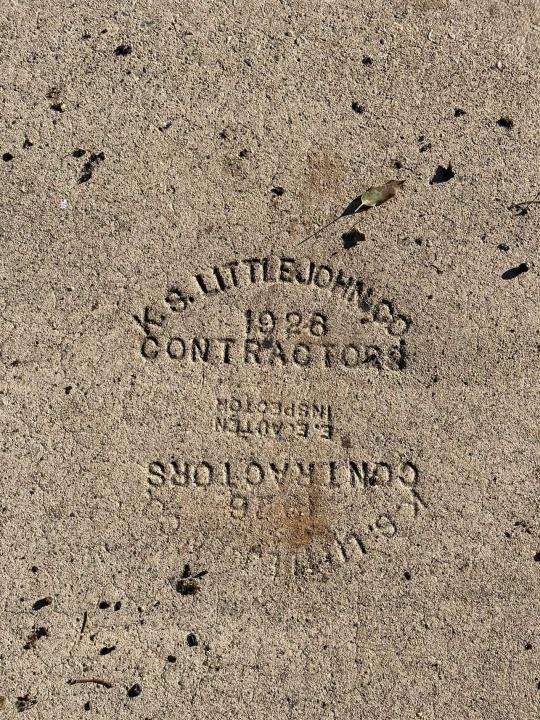
K. S. Littlejohn Co Contractors 1926 (Photo taken by Scott Fajack on December 23, 2022 on Ocampo Dr at W Pampas Ricas Blvd. in the Rustic Canyon neighborhood near/ in the Pacific Palisades, CA).
I believe this Littlejohn is Captain Kenneth Stuart Littlejohn, who was born February 6, 1876 or 1877 in Montclair, New Jersey and died September 18, 1952 in Mexico. His father was Frank Bennoch Littlejohn and his mother was Elise (maybe Elsie) Thomson Stuart. He married Josephine Keizer (1887-1963), daughter of Mr. and Mrs. Dell Keizer, of Kansas City, Missouri. Their engagement was announced on page 34 of April 2, 1911 issue of The Kansas City Star (findagrave.com) and they were married May 18, 1912 in California (https://www.wikitree.com/wiki/Littlejohn-725#_note-0). He had a son Kenneth Keizer (1926-1950), who was born in Los Angeles, and three daughters - Virginia (1914-2000), Eleanor Stuart (1915-1977), and Lorna Jean (1916-1989). You can see them listed in the Fifteenth Census of the United States: 1930 Population Schedule seen here for the ���Beverly Hills Township.”
In WWI, he was in the Sixth U. S. Engineers and “was recognized for bravery at the battle of Claire Chenes Woods, France” (History of the Sixth Engineers, Knickerbocker Press, 1920. Entry for Captain Kenneth S. Littlejohn, page 274).
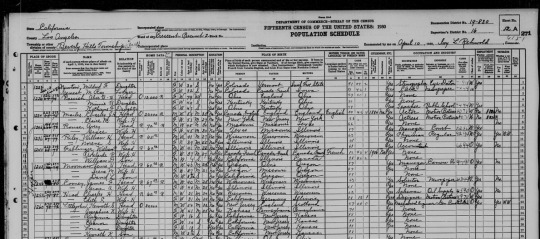
Littlejohn was given the contract for the canal digging by dragline excavator of Canal Rosales in Sinaloa, Mexico. “The work is somewhat out of the ordinary, as it is not a common thing for dragline excavators to be used for this purpose in Mexico, as native labor and mules are so plentiful and so cheap that they can almost compete even on big work with machine excavation.” (Not sure how much the laborers were making a fair living or not in that scenario!) At the time of this contract, the company was based in Tucson, Arizona. The foreman in charge of this project was Otto G. Fladung of Tucson. (”Canal Digging with Dragline Excavator in Old Mexico,” Excavating Contractor, Volumes 15-16, A.B. Morse Company, 1921). Fladung was born April 4, 1892 in Ohio and died February 10, 1923 in Tucson. He’s buried in the Saint Louis Cemetery in Louisville, Ohio.

They lost a bid for work in Phoenix, AZ in 1922 (Southwest Builder and Contractor, Volume 60, F. W. Dodge Company, 1922), but they were awarded the contract for street work for Florence ave. between Van Ness Ave. and West Blvd. by the Los Angeles Building and Public Works department (Building and Engineering News, Volume 26, Issue 2, 1926).
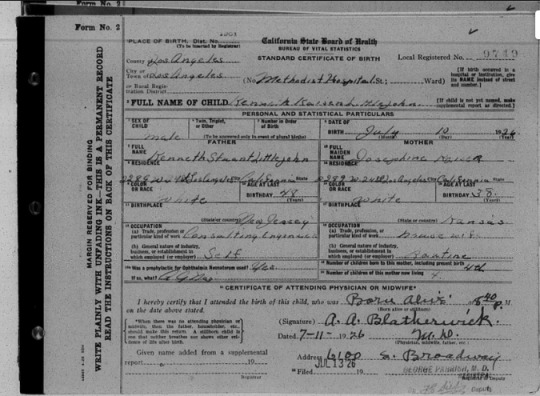
At the time of Kenneth Keizer’s birth, they lived at 2289 W 24th Street, in the Jefferson Park neighborhood of Los Angeles just south of the current 10 freeway. The house is still there - Zillow says the current house there was built in 1905. Kenneth Kaiser’s birth certificate gives me more confidence that Kenneth Stuart is the correct K.S. Littlejohn, as it lists his occupation as “Consulting Engineer” and his employer as “Self.”
K. S. Littlejohn Co. Engineers and Contractors are listed with K.S. Littlejohn and R.K. Walker in the Charter of the City of Los Angeles in Effect July 1, 1925 (Los Angeles Daily Journal, 1925). They can also be found in the Los Angeles County Incorporation Records (Second Series) 1903-1939 at the Seaver Center for Western History Research, Natural History Museum of Los Angeles County. In the Los Angeles City Directory 1925, the company’s principals are listed as K S Littlejohn and E T Brown, with their office at 626 S Spring Street, room 609 (Los Angeles Directory Company, Los Angeles, CA, 1925, accessed via the Los Angeles Public Library). Today that address has some bars and studio loft apartments, not 100% sure it’s still the same building but probably.
Littlejohn was one of the contractors in Fillmore, CA involved in the repair work after the St. Francis Dam Disaster, under the supervision of general director C. E. Bressler (Hundley, Norris and Jackson, Donald C. Heavy Ground: William Mulholland and the St. Francis Dam Disaster, University of Nevada Press, 2020).
0 notes
Text
The Family Code of the Philippines
Title VIII - Support
Republic of the Philippines SUPREME COURT Manila
EN BANC
G.R. No. L-26231 August 7, 1926
LORENZO MENDOZA, petitioner, vs. GORGONIA PARUNGAO, Honorable EDUARDO GUTIERREZ DAVID, Judge of First Instance of Nueva Ecija, GABRIEL BELMONTE, sheriff ex-officio of Nueva Ecija, and Honorable MANUEL V. MORAN, Vacation Judge of First Instance of the Court of Nueva Ecija, respondents.
FACTS: In the case at bar, petitioner Lorenzo Mendoza filed a writ of certiorari against Gorgonia Paruñgao, Nueva Ecija ex-officio sheriff Gabriel Belmonte and Judges Eduardo David (Nueva Ecija CFI) and Manuel Moran (Vacation Judge of Nueva Ecija) to prohibit the carrying out of sale of property of petitioner and forward the case to the Supreme Court for revision.
On August 1925, the CFI declared Mendoza and Paruñgao’s marriage null and void upon the reappearance of the Paruñgao’s first husband Antonio Buenaventura, who was considered dead after an absence of more than 7 years. (Buenaventura died later on.) While the first judgment was on appeal, Paruñgao filed for alimony and settlement of her conjugal property with Mendoza on September 1925.
Subsequently, the court directed Mendoza to give Paruñgao monthly support. However, the writs of execution were not complied with.
On July 10, 1926, the CFI denied Mendoza’s motion for reconsideration regarding support. On July 23, the Supreme Court affirmed the nullity of Mendoza and Paruñgao’s marriage.
ISSUE: Whether or not Paruñgao, when she filed for liquidation of conjugal property and alimony, is entitled to support during pendency of the action
RULING: No. While a wife is entitled to support during the pendency of an annulment suit, this right ceases along with other mutual obligations of marriage after the decree of nullity is issued. The marriage between Mendoza and Paruñgao was annulled on August 1925. She was, therefore, no longer entitled to support on September 1925 when she filed the complaint. However, Paruñgao is entitled to payment in advance of her share to the conjugal property, if such exists. CFI’s order of monthly payment is to be considered an advance of conjugal property share but no writ of execution can be issued thereon because of excess of jurisdiction and its interlocutory character.
0 notes
Text
The Life and Times of Queen Elizabeth II: An Era of Transition and the Future of the British Monarchy

Queen Elizabeth II, the longest-reigning British monarch in history, ascended to the throne on February 6, 1952, and her reign lasted until her death on September 8, 2022. Born Elizabeth Alexandra Mary Windsor on April 21, 1926, her life and reign encapsulated a period of extraordinary change both within the United Kingdom and across the globe. Her tenure saw the transformation of the British Empire into the Commonwealth, the end of the Cold War, the dawn of the digital age, and significant shifts in social norms and values. As the figurehead of the UK and 15 other Commonwealth realms, her consistent presence provided a sense of continuity amidst these vast changes. Early Life and Ascension Elizabeth was not born as the direct heir apparent to the throne; her destiny changed with the abdication of her uncle, King Edward VIII, in 1936, which made her father the king and her the next in line. Educated privately at home and serving in the Auxiliary Territorial Service during World War II, Elizabeth's early life was a blend of royal duty and service to her country. Her marriage to Philip Mountbatten in 1947 was a union that lasted 73 years, until his death in 2021, and played a central role in her life and reign. Together, they had four children: Charles, Anne, Andrew, and Edward, whose lives and activities have also been closely followed by the public. Reign and Legacy Throughout her reign, Queen Elizabeth II navigated the monarchy through times of both turbulence and triumph. She worked with 15 UK Prime Ministers, from Winston Churchill to Liz Truss, and met with numerous world leaders, influencing diplomatic relations through her engagements. Her reign was marked by a dedication to public service, with countless engagements, state visits, and ceremonial duties performed with unwavering commitment. Elizabeth's ability to adapt the monarchy to the times without sacrificing its traditions was among her most notable achievements. She embraced television and the internet to connect with the public, including the annual Christmas broadcast, which became a significant aspect of her communication with the Commonwealth and the world. Death and Transition The death of Queen Elizabeth II marked the end of an era and the beginning of a new chapter for the British monarchy. Her son, Charles, succeeded her as King Charles III, bringing to the throne a different perspective shaped by years of advocacy on environmental, social, and architectural issues. The Future Monarchy King Charles III faces the challenge of leading a monarchy in a modern, more questioning world. With debates surrounding the monarchy's funding, its role in society, and the relevance of the Commonwealth in the 21st century, his reign is poised to be one of adaptation and potential transformation. Charles has indicated a desire to streamline the monarchy and focus on sustainability and social issues, which could redefine the royal family's role in British society and beyond. The transition also raises questions about the monarchy's place in the UK and its relevance to younger generations. While the monarchy has historically enjoyed strong support, changing demographics and societal values suggest that its future role may need to evolve. The life and times of Queen Elizabeth II represented a bridge between centuries, embodying tradition while facing forward. As the British monarchy enters a new era under King Charles III, it stands at a crossroads between its historical legacy and the demands of a changing world. How this institution adapts will likely define its relevance and survival in the years to come, continuing a story that has fascinated and engaged people around the globe for more than a millennium. Read the full article
3 notes
·
View notes